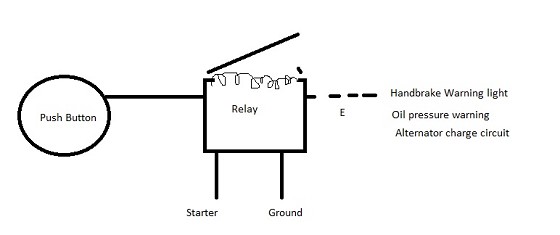|
|
|
riahon:
You could go super rad and have some sort of shield that slides back over the button like a jetfighter where you flick aside a plate, press the button and then is slides back over. That would be cool.
If you also placed the starter button on the right hand side of the steering wheel then the only one that can accidentally press it would be the driver.


ArtooDetoo:
I'm no electrician, but I would think a simple solenoid would do what you're asking.
In the solenoid's 'relaxed' state, the contacts are bridged, completing a path to the live terminal of the starter motor's own solenoid. That path is then broken only by your starter button which, when pressed, completes the circuit to the starter motor and as long as the button is depressed, the starter will turn.
But... as soon as the engine fires, the charging circuit takes over the battery's task of supplying energy, so you can tap into that to feed power into your solenoid, energising it, which in turn pulls the bridge away from the contacts of your starter button circuit which then breaks that circuit and no matter how much you hold the starter button down, the circuit will remain broken by the solenoid.
The solenoid will only relax again and bridge the contacts of your starter circuit if the charging circuit is no longer producing sufficient voltage - that is, when the engine stops.
Maybe $60 for a solenoid, wire, fuse carriers (one for the starting circuit and one for the solenoid powering circuit), some spade terminals and solder.
In summary, your solenoid completes your starting circuit except for your start button. Push the button and power flows to the starter. As soon as the engine starts, the charging circuit (from the alternator and rectifier) fires up and the power from this circuit energises your solenoid, dragging the contact bridge away from the starting circuit, breaking that circuit and rendering the start button non-functioning.
As soon as the engine stops, however, the charging circuit voltage goes to 0 and allows the solenoid to return to its relaxed state, once again bridging the break in your starter circuit. Which means that when you push the start button, power will again flow to the starter. Bear in mind that the power for your start circuit should come from the ignition switch terminal that currently (no pun intended) is one position before the spring loaded key position.
Hmmmm
cisconz: But now to the reason I quoted, as cars run a single dc system, for the solenoid to work you will need to put a diode between the alternator and the rest of the cuircut's as otherwie your solenoid will recieve voltage from the battery and the alternator so will never be in its "relaxed" state.
A diode at the correct current rating will not be cheap, someone else should be able to tell you where to get a diode that large.
ArtooDetoo: The trick with that though would be to find a relay that breaks rather than makes a circuit when energised, something that's not too common.

Jaxson:ArtooDetoo: The trick with that though would be to find a relay that breaks rather than makes a circuit when energised, something that's not too common.
Just use the Normally Closed (NC) contacts on the relay output, or vice versa. There are only two options so one will achieve what you are after.
tombrownzz: with a starter button, is it secure? what happens if someone breaks into your vehicle and just pushes the button to start it without using a key?
tombrownzz: with a starter button, is it secure? what happens if someone breaks into your vehicle and just pushes the button to start it without using a key?
Aaroona: My new car is currently getting certified etc and I am wanting to install a starter button.
I just have a few questions though;
How am I able to stop the button from burning out the starter motor if the button is pressed while the car is running? A mate of mine has just wired up a start button in his car, but his will burn out the starter motor if its pressed while his car is running - a potential problem if you have people in your car who are sticky fingers and like to fiddle.
|
|
|
